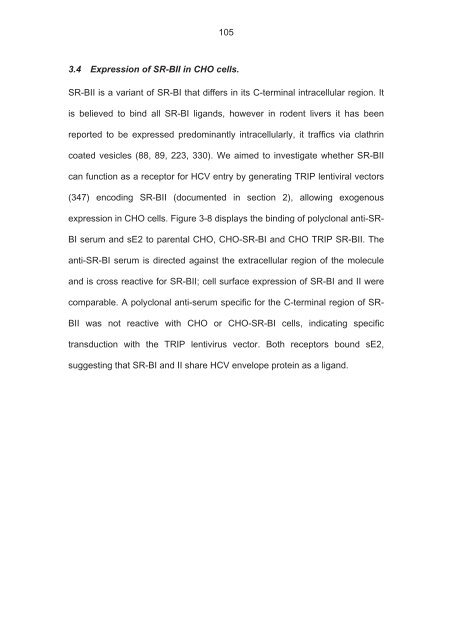The role of scavenger receptor BI in hepatitis - eTheses Repository ...
The role of scavenger receptor BI in hepatitis - eTheses Repository ...
The role of scavenger receptor BI in hepatitis - eTheses Repository ...
Create successful ePaper yourself
Turn your PDF publications into a flip-book with our unique Google optimized e-Paper software.
105<br />
3.4 Expression <strong>of</strong> SR-<strong>BI</strong>I <strong>in</strong> CHO cells.<br />
SR-<strong>BI</strong>I is a variant <strong>of</strong> SR-<strong>BI</strong> that differs <strong>in</strong> its C-term<strong>in</strong>al <strong>in</strong>tracellular region. It<br />
is believed to b<strong>in</strong>d all SR-<strong>BI</strong> ligands, however <strong>in</strong> rodent livers it has been<br />
reported to be expressed predom<strong>in</strong>antly <strong>in</strong>tracellularly, it traffics via clathr<strong>in</strong><br />
coated vesicles (88, 89, 223, 330). We aimed to <strong>in</strong>vestigate whether SR-<strong>BI</strong>I<br />
can function as a <strong>receptor</strong> for HCV entry by generat<strong>in</strong>g TRIP lentiviral vectors<br />
(347) encod<strong>in</strong>g SR-<strong>BI</strong>I (documented <strong>in</strong> section 2), allow<strong>in</strong>g exogenous<br />
expression <strong>in</strong> CHO cells. Figure 3-8 displays the b<strong>in</strong>d<strong>in</strong>g <strong>of</strong> polyclonal anti-SR-<br />
<strong>BI</strong> serum and sE2 to parental CHO, CHO-SR-<strong>BI</strong> and CHO TRIP SR-<strong>BI</strong>I. <strong>The</strong><br />
anti-SR-<strong>BI</strong> serum is directed aga<strong>in</strong>st the extracellular region <strong>of</strong> the molecule<br />
and is cross reactive for SR-<strong>BI</strong>I; cell surface expression <strong>of</strong> SR-<strong>BI</strong> and II were<br />
comparable. A polyclonal anti-serum specific for the C-term<strong>in</strong>al region <strong>of</strong> SR-<br />
<strong>BI</strong>I was not reactive with CHO or CHO-SR-<strong>BI</strong> cells, <strong>in</strong>dicat<strong>in</strong>g specific<br />
transduction with the TRIP lentivirus vector. Both <strong>receptor</strong>s bound sE2,<br />
suggest<strong>in</strong>g that SR-<strong>BI</strong> and II share HCV envelope prote<strong>in</strong> as a ligand.

















